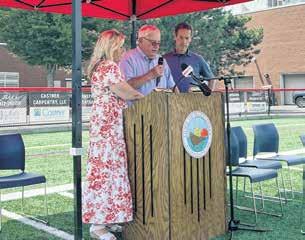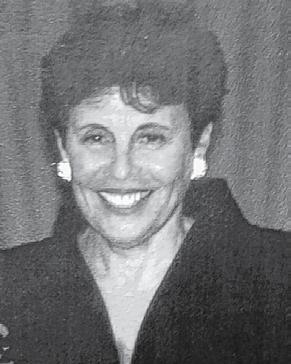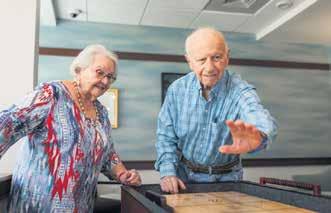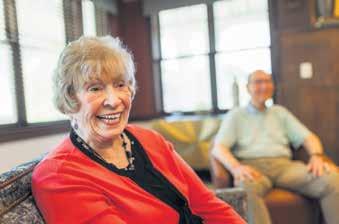






BY WILL DOWD
The Marblehead Select Board outlined a three-part strategy July 18 to address the town’s noncompliance with state housing law after voters rejected required zoning changes July 8. The approach includes
BY LAURIE FULLERTON
The 136th running of Marblehead Race Week featured strong performances by both local sailors and world-class professional teams. The pros were here to not only win Race Week but to prepare themselves for upcoming national and world championships. Sailors came from as far away as the United Kingdom, Bermuda, California, Texas and Florida to compete over four days of racing for some fleets, and three days for others. With 10 fleets racing on three lines, the J/70 fleet faced fierce competition, but it was two-time Rolex Yachtsmen of the Year and 10-time world champion Jud Smith of Marblehead and his team including Peter Duncan, Willem van Waay and Victor de Leon who took first place in the J/70 fleet. The win also netted the team the Norm Cressy Award for best performance at Marblehead Race Week.
“It is never easy racing in Marblehead, and I have been sailing here for over 60 years, and it is always surprising,” Smith said. “It has its own set of challenges and the idea that
preparing a revised proposal for 2026 Town Meeting, exploring direct state engagement for compromise alternatives and accepting noncompliance while mitigating consequences. Board members agreed to pursue multiple paths simultaneously during a goals-setting retreat at
the Municipal Light Department.
Planning Director Brendan Callahan told officials the town faces immediate pressure from state enforcement expectations.
“We really can’t just sit until January,” Callahan said, referring to when Attorney General Andrea Campbell is
expected to begin enforcement actions. “We need to know what we’re doing.”
Town Administrator Thatcher Kezer presented the three scenarios during retreat discussions. The noncompliance option acknowledges potential legal challenges while

there is local knowledge is a myth, but the bottom line is that at this Race Week we did have wind, and we are glad we did well. We will be competing against some of these teams and more in Argentina in October. “ The fleet was chock full of world class sailors meeting either before the J/70 worlds in October in Argentina or here in Marblehead in September when the Eastern

Yacht Club hosts the J/70 Corinthian worlds, which is for non-professional teams.
Charlie Pendleton and Jim Raisides, both of Marblehead, were ninth overall in the J/70 fleet but are counted as finishing second in the Corinthian (nonprofessional) J/70 class which bodes well for them in September when the town hosts the J/70 Corinthian Worlds.
“We are looking forward to the J/70 Worlds but being out there this week and sailing well against some of these top professional sailors is amazing practice. For us, it is like racing against the Tiger Woods or Michael Jordans of sailing. It has been great to sail well,” Pendleton said.
The 22-boat strong Etchells fleet saw four-time world champion Luke Lawrence of
attempting damage control.
“If we’re not going to become compliant, I think what we’re going to try to do is just mitigate the lawsuits, mitigate the downside to the whole thing,” Kezer said.
BY LEIGH BLANDER
More than 100 people gathered on Piper Field Friday for a ceremony dedicating the Marblehead High School field house in honor of longtime teacher, coach and athletic director Alex Kulevich. His name now appears in large letters across the outside of the field house.
The Kulevich family also
announced a new $100,000 foundation, sponsored by Steve and Joan Rosenthal, for the field house. Steve played football for Kulevich, and Joan was his history student.
Kulevich has been a local legend since the 1970s when he first came to take over the high school football program. He was also a full-time social studies teacher.
In 10 years as a coach, Kulevich
Biscayne Bay Yacht Club and Peter Shumaker of Bayview Yacht Club finish first with 17 points. The fleet featured a lot of traveling teams but is also seeing the resurgence of younger local talent like Marblehead’s Will Hundahl who placed ninth overall mentored in part by Etchells sailor and world class competitor Tomas Hornos of Marblehead whose team placed seventh overall.
“The local Etchells Fleet 4 has been continuously racing in these waters for well over 50 years,” Hornos said. “We are thrilled to see that the class is seeing a resurgence, and Fleet 4 is doing a good job creating opportunities for younger people. Recently, a donated boat has been slowly transitioning to becoming a ‘Pleon Etchells’ available to junior sailors.” In the Rhodes-19 class, Marblehead’s Nate and Jim Taylor took first place with 48 points, with Larry Ehrhardt and George Maclomson finishing a close second with 49 points. Debbie Noble and Adam Roberts placed third with 52 points.
“The Rhodes-19 sail four days,
established a winning culture before stepping away from the sidelines to become the school’s athletic director, a position he held for 20 years until he announced his retirement in 2000.
“I did my best to instill confidence in my students and athletes and get them to understand the importance of

BY LEIGH BLANDER
The Republic Services trash strike, which is impacting Marblehead and 13 other North Shore communities, could enter its second month on Aug. 1. As of Monday, July 28, negotiations had stalled.
Marblehead Public Health Director Andrew Petty delivered an update July 22, saying that replacement workers on two trucks will continue to work in town. Republic’s union workers walked off the job July 1, asking for competitive wages and benefits.
Three weeks into the strike, Petty said the Health Department was receiving a “fraction” of the calls and emails it had been receiving reporting missed trash pick-ups.
“The first couple days, we were getting 500 emails a day, and the phones were ringing off the hook,” he said.
Petty continued, “People are using the Transfer Station, which is wonderful. We are very, very lucky for that facility.”
Petty reported that on July 22, more than 1,000 cars had entered the Transfer Station by 2 p.m.
He again encouraged residents to bring their

trash and recycling to the Transfer Station and to leave trash curbside on regular pickup days. Do not place recycling at the curb. If trash is not collected, call the Health Department (781-631-0212) to let them know. Republic’s replacement workers will start the following day with missed streets.
If a specific house is missed, Petty’s team will come out and collect that trash.
On some of Marblehead’s smaller, hard-tonavigate streets, the town’s DPW is picking up trash.
The Republic replacement employees work 7 a.m.-5 p.m., and the drivers have to stop after 60 hours in one week, Petty explained.
A “gluttony” of recycling is being dropped at the Transfer Station, according to Petty, who said there has been a 100% increase in recycling brought to the dump. The company Waste Management removes the recycling from the Transfer Station at least once a day. Since the strike, Waste Management has been coming up to four times a day.
“We are able to keep up with the capacity,” Petty said.
Petty also explained that he will review Republic’s July bill when it arrives and “see what we want to take off.”
Also at the meeting, Board of Health Chair Dr. Tom Massaro pitched the idea of leading a three- or four-part series educating residents about the health care industry. Health spending totaled nearly nearly $5 trillion in 2023, or $14,570 per capita, according to the American Medical Association.
Massaro suggested several topics including: who is spending that money and where does it go; what are Medicare and Medicaid; and the role of health insurance.
New facilities subcommittee reviews two options to address leaks
BY LEIGH BLANDER
The School Committee’s new facilities subcommittee will climb to the top of Marblehead High School on Friday, Aug. 2, to get an up-close-and-personal look at the leaky roof. The subcommittee met July 24 to hear new information on two options to repair the roof.
Voters have approved nearly $14 million in debt exclusion overrides for the project. The School Committee will decide on whether to move forward with a full roof membrane replacement or a “fluid applied” approach that would prevent future leaks. The fluid applied approach could save about $1.6 million.
Left Field Project Management, which is leading the work, listed pros and cons to each approach.
A roof recover is more expensive and offers a 20-year,
BY WILL DOWD
The Current welcomes submissions (150-200 words) to the news in brief. Send yours to info@marbleheadnews.org
New ambulance company
to serve town
The Select Board unanimously approved a new, three-year ambulance services agreement between Marblehead, Swampscott and Beauport Ambulance Service Inc., marking a significant shift in emergency medical services. The joint procurement was developed to enhance competitiveness and service quality by leveraging the combined call volume from both towns, creating sufficient critical mass to attract better service providers.
Under the contract, Beauport will bill patients and third-party insurers directly for services rendered, requiring no municipal funds for basic service delivery. Each town will receive one fully staffed ambulance operating around the clock, with additional basic life support coverage provided during peak hours. All vehicles will be newly purchased and co-branded to reflect service to both towns.
The agreement establishes comprehensive performance standards for response times, with the first ambulance required to arrive on scene within six minutes 90% of the time. Monthly performance reports will be provided, and

full-system warranty. It includes a new roof membrane and a longer lifespan. Any roofer can perform maintenance and repairs.
A roof restoration (fluid-applied approach), is less expensive and offers a 20-year warranty limited only to the coating. No new membrane will be installed.
“There are several differences
between the two options, including cost, application type,” explained Assistant Superintendent for Finance and Facilities Mike Pfiffering. “The liquid applied barrier is a newer product that doesn’t have more than 10 years of history. The membrane install includes new fascia, the membrane install


regular coordination with local emergency departments is required. Beauport operates bases in Gloucester, Hamilton, Beverly, Danvers and Boston, providing backup coverage when primary units are occupied.
Town Administrator Thatcher Kezer noted additional cost
savings through supply arrangements, where medical supplies used by the fire department will be replaced on a one-for-one basis by Beauport rather than being a direct municipal expense. The company also committed to donating 5% of annual profits from this

FOR
CHAIR Bob Peck
has seams, which are the most common failure point in a roof system.”
According to Pfifferling, the following is the project timeline:
» Architect creates schematic design and bid documents, now through Sept. 15/ School Committee forms a work group to “pre-qualify” all bidders, Sept. 1-Nov. 30.
» Bidding period, Oct. 1-Nov. 15 (dates are estimated).
» Bid selection – late November.
Construction contract(s) awarded – December (requires School Committee and Select Board approval)
» Construction period – June 1-Oct. 31, 2026 It is likely the roof project will be discussed at the School Committee’s upcoming meeting on Thursday, July 31, 6 p.m.
agreement back to Marblehead and Swampscott community organizations and will host four community safety events per year at no cost to the towns.
Beauport Ambulance, established in 1984 and under current ownership since 2004, serves approximately 20,000 emergency transports annually and provides 35,000 non-emergency ambulance transports. The contract includes termination provisions allowing either municipality to withdraw with six months written notice.
Service begins Aug. 15.
Park project transforms cistern into design feature
The Elm Street Park renovation project experienced an unexpected two- to threemonth delay following the discovery of a massive granitelined cistern built in 1858, but town officials have successfully transformed the challenge into an enhancement for the final design.
The underground structure was discovered when heavy equipment created a hole seven feet down to water, revealing another 20 feet of water depth beneath.
Rather than disposing of the massive granite blocks that lined the historic cistern, the town integrated them into the park’s design as both functional and aesthetic elements. The carefully crafted stonework, assembled without cement using traditional techniques, yielded extremely
REACT We’re standing by to listen to your ideas. Please drop us a line and let us know what you would like to see in your community newspaper. Send your thoughts to info@marbleheadnews.org.
IN MEMORIAM Ed Bell, co-founder, co-chair (2022-2025)
Help keep the Current coming by scanning this QR code. Thank you!

and we have a total of 11 races, and it is grueling,” said 76-year- old yacht designer Jim Taylor. “I am lucky to sail with my son, Nate, and we have been racing together for over 15 years as adults, and he always raced with me when he was a youngster. He drives the boat now and he is a good sailor. But this was close. We went into the final race today, with our 11-point lead from the day before down to one point. In the final race we finished third by a hair but that gave us enough points to win it overall.” In the Town Class fleet, which featured 11 boats, Andrea Dodge and Nick Caan of the Dolphin Yacht Club took first place with 25 points. Second place went to Molly and Tom Bushman of the Eastern Yacht Club with 40 points, and third place went to David Cooke and David Goldsmith of the Corinthian Yacht Club with 42 points. “It was a rough few days of racing for the Town Class and on the final day it was blowing about 25 knots. Much of the fleet thought it might be too windy to race but finally the wind died down before the start,” said Caan who has been racing Townies for about five years. “After some rough weather over three days. It was exhausting and exciting.” Marblehead’s Nicolas Regnault won the Laser Class with 13 points. At age 18, Regnault has been competing very well and said, “It was my goal this time to place first, and I am extremely proud that I reached it. I have been pointing very well and keeping the boat flat and did have a slight advantage when I picked the correct side of the course on the second to last day of racing. Today it was also strong winds,
but I think I was just into a good groove, and it just happened to be a strong regatta for me.” In the J105 fleet, Charlie Garrard was fighting hard for a podium finish particularly against the rival team from Texas, ending up third overall with 26 points.
In the eight-boat strong International One Design fleet, the octogenarian Bill Widnall won first place with 17 points.
“We made mistakes, especially with some of our starts but we clawed our way back. Our teamwork was also excellent,” Widnall said.
Carolyn Corbet and her team placed second with 20 points followed by Greg Mancusi Ungaro and his team who finished third with 29 points.
Finally, the Lightings and the 110s, both fleets that once had a big presence in Marblehead and returned just for Race Week had a strong win by visiting teams Connor Godfrey of New York winning with 18 points in the Lighting fleet. South Shore sailors Joe Berkeley and Linda Epstein took first in the 110-fleet winning with 15 points.
For race committee chairman Mike Michaud, the overall event faced challenges on the water with changing weather and strong winds. But he feels they put together a great regatta with an amazing long stretch of highly competitive sailing.
“The wind shifts made it challenging and on Friday, we did get a squall with wind gusts to 30 knots but we put all three lines with varying conditions quite well,” Michaud said. “We have been planning this event since January, and the caliber of sailors and the sponsor Helly Hansen has made it something we were really looking forward to. It was challenging but overall, an excellent Race Week.”
BY GREY COLLINS
Nearly 180 young sailors boarded their vessels the morning of July 21 and sailed them out of Marblehead Harbor to face off on the first day of the Junior Race Week. They spent the next few hours sailing in heavy wind, big waves and challenging conditions. But this was just the first of three days of sailing.
Junior Race week took place July 21-23, and included four races per day for 8-to 18-yearold sailors. Many are Marbleheaders, but others come from all around New England to participate in this historic regatta. The Marblehead Race week was first introduced in 1889, making this the 136th annual Race week, and one of our town’s most treasured traditions. Last year, a lack of wind canceled all but one race at the Junior Race Week. Since beginning to organize the races back in January, the officials and sailors have been hoping that this year might be different. They were delighted to see wind speeds of up to 20 mph on Monday. This allowed for fast racing, and combined with big waves to create challenging conditions for the sailors. But it also

gave these sailors a rare opportunity to test their skills.
“It’s going terrific, relative to last year, we’ve gone from famine to feast,” said Junior Race Week Co-Chair Jim Da Silva, who has been organizing the race week for four years. “Yesterday being a windier day than average, a lot of sailors were able to test their limits. And when you test your limits in a controlled and safe environment, it can be a really special experience.”
The racers took to the waves in three types of boats: Optimists, C420s and Lasers. The buoys marking the race courses were placed by race committee boats near












Children’s Island and Chandler Hovey Park.
On Wednesday, after three days of racing, the points were counted to determine an overall winner for each category.
The winner of the Opti Green races was




At one point in our nation’s history, measles infected millions of Americans. Later, in the year 2000, the U.S. declared a milestone success in effectively eradicating the disease. In 2025, according to the Johns Hopkins Bloomberg School of Public Health, the U.S. is seeing the most reported cases in decades. As of July 15, the Centers for Disease Control identified 1,309 confirmed cases in 39 states, including our very own New England neighbors, Rhode Island and Vermont. To put this in context, the CDC identified only 285 cases in 2024.
These worrying numbers — fueled in part by confusing signals from Washington, it would seem — reflect a disturbing unraveling of a public health success story and could reintroduce a highly preventable and highly communicable illness. There may not be an immediate cause for concern here in Marblehead, as The Boston Globe reports that Massachusetts has high vaccination rates compared to the nation at large. But those rates are declining among kindergarteners, which create pockets of measles vulnerability often found in specific schools. So, while it is true that measles is not yet Marblehead’s problem, the “yet” is the key.
Fortunately for us, we live in a region that has access to a world-class and robust healthcare system. The Commonwealth Fund this year ranked Massachusetts first in the U.S. for its health system’s performance in terms of access to care, care quality and outcomes, among other factors. Similarly, we are fortunate to have informed and engaged public health officials and lawmakers promoting and enacting policies at both the state and local levels that positively impact public health and safety.
Yes, to be fair, the COVID-19 pandemic revealed that the public health system operates in a complex, dynamic environment and that officials do not always get it right for everyone. Information evolved. Unprecedented challenges frequently arose. COVID-19 showed us that public health strategies can and should change to keep up with new data and learnings, always with an unwavering commitment to promoting the best possible health outcomes for all.
Measles is not COVID-19, however. The measles vaccine has been used and studied relentlessly since the 1960s, and the scientific and medical communities are unequivocal. As the CDC states, the vaccine provides 97% protection and is safe and effective. And, when a community achieves an estimated 95% vaccination rate, the entire community receives so-called herd immunity, which means the disease cannot easily spread.
Because measles is so contagious yet preventable, Massachusetts requires vaccination for admission to public school. There are two exemptions. One is medical (when an individual cannot medically receive the vaccine), and one is religious. To use the latter, a parent or guardian must only state in writing that a vaccination conflicts with their “sincere religious beliefs.”
It is time to revisit the religious exemption.
As the Current reported in 2023, it appears to be at the heart of declining vaccination numbers locally and across Massachusetts. Because of trending numbers, the exemption is one of the bigger obstacles to maintaining herd immunity and protecting our most medically vulnerable citizens — those who cannot take the vaccine for medical reasons and are thus most at risk for infection.
Two pending bills in the Massachusetts legislature (H.2554 and S.1557) seek to fix the problem. They would eliminate the religious exemption and introduce language to strengthen vaccine oversight by requiring annual reporting of school vaccination rates to enhance vaccine education and outreach.
If enacted, Massachusetts would join Connecticut, Maine and New York, among a few other states, in eliminating their religious exemptions. The bills are worthy of your review and support.
Now, no one should take burdening the exercise of religion lightly. The reality, though, is that very few religions actually prohibit vaccinations (even Christian Science, which focuses on spiritual power to heal sickness, does not ban vaccines). Consequently, many people may be misusing (innocently or not) the exemption to opt out of vaccinations because of general vaccine hesitancy. When balancing the protection of religious practices with the protection of our community’s most vulnerable, we must prioritize protecting the vulnerable. Our courts have nearly uniformly recognized the appropriateness of this balance. States’ legislative efforts to pull back religious exemptions have been upheld as a constitutionally acceptable tool to guard against public health and safety risks.
The health of our community, especially our children and most medically vulnerable, is a shared responsibility. They deserve a future free from preventable diseases. That responsibility calls for aligning time-tested and evidence-based standards of care with public health policies for the common good.
Marblehead deserves nothing less. It is time to support our state legislature as it works to eliminate the religious exemption for school vaccinations.
BY LIZZIE ASSA

This past weekend, I sat on the beach with my husband, sans kids. We have teens now, and our tween is away at camp, hence the kidless beach situation. I was lying back in my beach chair, sun on my face, warm breeze in my hair, but noticing the absence of a wiggling toddler in my lap, giving me damp, sandy kisses. I miss those days something awful. My eyes scanned the beach, admiring all the hardworking parents who were vigilantly standing at the water’s edge, keeping their kids safe in the waves. I smiled in solidarity at the mom picking Cheetos out of the sand, brushing them off and feeding them to her crying toddler.
But something felt off. I kept noticing how many parents were working so hard to get it right. Too hard. They were jumping in to help, redirecting, offering options, all with love and good intentions. But over and over, I kept seeing how trying to optimize every experience was actually making things worse for everyone.
I recognized this pattern because I’d lived it myself. In my early parenting years, especially with my oldest, I was the queen of over-optimization. I’d burned myself out trying to make every moment count, every experience perfect. But my background as an early childhood educator kept whispering a truth I was slow to accept: less adult input often means more meaningful play for kids.
Back to the beach:
There was a group of kids, probably between 4 and 8 years old, marching around the playground like a little gang of pirates. They were sandy, loud and totally in it. Summer magic.
Two moms stood nearby, chatting. Everyone looked settled.
Then a third mom walked up with a baby on her hip and called out, “Seth, honey. Don’t you want to play by the water? Want a snack? Some juice?”
Seth didn’t answer. He was deep in pirate mode. He barely looked up. But the other kids heard “snack,” and the whole energy shifted.
Next thing I saw, she was passing out small bags of Goldfish, chips and carrot sticks to a band of sticky open palms. The toddler on her hip was writhing, trying to get a carrot stick. The mom kept trying to give the toddler a sippy cup instead, overexplaining about choking, while simultaneously convincing a 6 year old to trade snacks with the crying4 year old who was tackling his brother for the last bag of Doritos.
There was a moment of silence as everyone contentedly chewed, when out came the sunblock tube. “Let’s get sunblocked,” she said to Seth, who was now rummaging in the open cooler for a Capri Sun.
The mom then asked her partner, who had just settled the toddler onto the blanket with a board book and a pacifier, to grab water bottles.
Seth kept digging. “I want a Capri Sun!” he whined.
To the editor: Here is why 3A was not democratic and not fair to voters of lower-income areas in the town:
The three zones that were expanded for 3A are areas of affordable housing, elderly housing, congestion, dump construction and density issues in the town already. Fair would be to make the whole town zoned for two- or three-family units without special permit. By doing this you will allow seniors who are struggling to stay in their small homes to be able to add a small apartment.
Owners with large homes could make three-family condo units. Let everyone share in the opportunity to provide affordable housing, not just a few. This would also limit large construction companies coming in and building. Traffic and construction would be spread throughout the town. Singlefamily homeowners living within a block or two of the current three

Both mom and dad looked tense, and those magical moments of pirate play were long gone.
And listen, no one meant to disrupt anything. But in the effort to enhance it, everything got pulled off course.
Toddler crying. Preschooler whining. Mom and dad irritated with one another.
Sound familiar? It does to me. I could have easily been this mom.
A mom who means well, wants to keep everyone safe, fed, hydrated and on track. But somehow, it always seems to backfire.
Later on, I saw a boy around five watching a man fly a fish-shaped kite. He was mesmerized.
The man noticed and smiled. They shared a quiet moment, just standing there in mutual curiosity. Then the boy’s dad came over and said, “Sammy, can you name that fish? From the movie? A clownfish. Can you say clownfish?”
The boy looked away. His interest dimmed. That quiet connection was replaced with a quiz.
Well-meaning Dad invited Sammy to go closer to the kite. He even offered to buy him one. He wanted to show him how to fly it. It was really nice, but it was too much.
Here’s the thing we forget: you don’t have to do more. You don’t have to optimize every single moment or guide every step. You don’t have to explain the fish. You can just watch, because watching is not lazy, and it is not missing an opportunity. It is choosing not to interrupt one.
Take a step back and observe your child. Observation is how you learn what actually lights them up. It is how you catch the flicker of interest before it gets buried under “helpful” noise. Letting your child take the lead and stumble is how they build confidence, creativity and self-trust, not from your direction, but from their own discovery. And most importantly, it is how you stop exhausting yourself trying to improve things that were already working just fine.
Next time you’re at the beach, the playground, or even your living room, try this: Don’t redirect. Don’t jump in with the ideas. Just watch. Count to ten in your head if you need to. You might be surprised by how capable they are. And you might feel more peace than you expected.
Lizzie Assa is founder of The Workspace for Children, a parenting strategist, play expert and mother of three who lives in Marblehead.
zones would not be the only ones subjected to jackhammers and blasting, and all the other kinds of construction disruption. They may have voted yes if the zoning was fair. Newport, Rhode Island has mansions that are now turned into three lovely condos. Would the state agree with this type of zoning? If yes then let’s vote again.
Valerie Pearson Ramsey Road
To the editor: As we read and watched the footage of the floods in Texas, we are all horrified and saddened by the devastation. The suddenness and ferocity seemed like another once-in-100-year phenomenon, but we are hearing this explanation all too often.
How could we be prepared for
and minimize such a disaster? We frequently count on public government agencies to predict and give timely warnings. In this case it fell to National Weather Service (The National Weather Service is part of National Oceanic and Atmospheric Administration), whose staff has been recently recklessly and dangerously cut, not only in numbers but in expertise, all in the “name” of reducing waste and fraud, (but without data to justify it.)
Initially there was lots of finger pointing, but it became clear, the scientists at NWS, short staffed as they were, did the best they could. They issued the warnings all night (1 a.m., 4 a.m., 6 a.m.). Yet as we know it is not just broadcasting a warning that can make a difference, it is how it gets relayed to those who are in harm’s way. This was a crucial link. Perhaps a better technology would have helped, but it wasn’t in place. It is the people who know the local climate, geography, towns, people etc.,
How to keep your house — and laundry — clean yet more sustainable
BY AMY BERENSON
Take a quick spin around your home. Do you see giant plastic laundry jugs squatting next to the washing machine?
Disposable soap dispensers on every sink? Spray bottles, detergent pods, stain removers — each in its own plastic shell?
Now, think about what happens to all that plastic once it’s empty. (If you’re tempted to say “recycled,” hold that thought.)
There’s good news, better options and a growing movement toward ditching the jug — without sacrificing clean clothes or sparkling counters.
Myth or fact: Is recycling broken?
You’ve probably heard the bleak statistic: only about 9% of all plastic produced globally is actually recycled, according to the Organization for Economic Co-operation and Development. That’s a gut punch — but context matters.
That figure applies to all plastic ever made, including industrial, medical and unmarked consumer plastics. Here in Marblehead, the news is better. According to Republic Services’ Materials Recovery Facility in Peabody, 80–85% of the material placed in our blue bins or brought to the Transfer Station does get recycled. That’s impressive — and a reminder that recycling here is well worth the effort.
Still, even well-run recycling programs can’t solve the growing problem of single-use plastic. Which is why reducing the plastic we bring into our homes in the first place is such a
powerful tool.
The laundry jug problem (and the easy fix)
Traditional laundry detergents come in hefty plastic jugs, most of which are bulky, leaky and only partially recyclable — if at all. To make matters worse, those jugs are mostly filled with water, meaning we’re shipping heavy containers of mostly liquid across the country, burning fossil fuels along the way.
And when they’re empty?
Many end up in landfills, oceans or incinerators. Even when recycled, the process is energyintensive and imperfect.
But here’s the good news: better alternatives exist, and they actually work. Many are even easier to use than the oldschool jug (no drippy caps or sticky residue!).
Great alternatives to plastic laundry jugs
If you’re ready to break up with the jug, you’ve got options:
» Laundry sheets: Premeasured, ultra-light sheets that dissolve in the wash. They come in slim cardboard boxes that are recyclable or compostable, and one pack can last for up to 60 loads.
» Concentrated strips or tablets: Just toss one into the washer. No measuring, no mess, no plastic.
» Powdered detergent in cardboard boxes: The retro champ is back, with updated, biodegradable formulas that work like a charm — and without the plastic waste.
» Refill stations: Some local stores offer bulk detergent

refills, letting you reuse the same container again and again.
Speaking of recycling … What can actually be recycled?
Plastic recycling can be confusing — and even wellmeaning folks can get it wrong. The golden rule: when in doubt, throw it out. (Wish-cycling — tossing in non-recyclables in hope — actually causes more harm than good.). It takes time and money to sort those out. Some can even damage the machines.
That said, here’s a quick cheat sheet for your blue bin:
» Paper: Can you tear it? Then it’s probably recyclable.
Plastic: Is it bigger than a credit card and rigid (not crinkly like chip bags)? You’re likely good.
» Avoid “tanglers”: Wires, hoses, coat hangers, long paper—these jam up recycling machinery.
No film or flimsy wrap: If it can blow away in the wind, keep it out.
Small changes –big impact
But the problem isn’t just laundry detergent. Most home cleaning products — from dish
soap to window cleaner— CC come in single-use plastic. But like with laundry., the alternatives are smart, easy and increasingly available. Many companies now offer: Concentrated tablets that dissolve in your own reusable spray bottle.
» Refill pouches that use less plastic and pack more product per ounce.
Bar soap or refill stations for hand soap and dish soap.
» You’ll find these at health food stores, local co-ops and even mainstream grocery retailers. Better yet, they often come with simpler, cleaner ingredient lists — and a lower environmental footprint.
About those “recyclable” labels …
Just because a product says it’s recyclable doesn’t mean it actually is — at least not here. The triangle with a number on the bottom? That’s a resin identification code, not a recycling guarantee. What’s accepted varies widely by municipality, so it’s worth getting familiar with Marblehead’s specific guidelines. (Spoiler: not all plastics marked with no. one through no. seven make the cut.)
The feel-good factor
Switching to sustainable home products isn’t just good for the environment — it feels good, too. Each time you skip a jug, reuse a bottle or choose a compostable box, you’re making a small but mighty choice.
You’re helping reduce landfill waste, ocean pollution and even
the carbon emissions from transporting heavy, water-filled products. And you’re sending a clear message to companies that consumers care about better packaging and smarter solutions.
Small changes, big impact.
Chemicals, waterways and what’s in your air
Let’s not forget what’s in conventional cleaners. Many mainstream detergents, soaps and sprays contain synthetic dyes, heavy perfumes and harsh chemicals — many of which wash into our waterways and linger in our homes.
Plant-based alternatives often rely on biodegradable, non-toxic ingredients that are safer for the planet and your family. (That’s a rabbit hole worth exploring, but we’ll save it for another column.)
Ready to ditch the jug?
Next time you’re restocking your home, pause before grabbing those bulky plastic containers. There are smarter choices now — and they’re not hard to find.
Start small. Try a new laundry sheet brand. Buy a soft refill packet for your soap dispenser. Or stash a reusable spray bottle under the sink and feed it tabletbased cleaners instead of buying new bottles every time. You’ll save money. You’ll save space. You could make your home healthier. And I hope you inspire your neighbors to do the same.
Amy Berenson is a Marblehead resident, Sustainable Marblehead member and environmental advocate who believes that small changes — like ditching plastic jugs — can add up to a cleaner world.
therefore, who provide this link. These were the people who no longer worked for NWS, either laid off or were in early forced retirement. And then sadly when the devastation is receding, our agency that comes to the “rescue,” Federal Emergency Management Agency, has suffered severe and reckless downsizing and senseless petty oversight of the needed funds, so they too are inadequate to the task.
These are just two recent examples of a policy that recklessly and without the basic knowledge of how agencies operate have made us unsafe and sadly without help.
We may think that this is happening someplace else, but with the warming of the climate (regardless of cause) this could soon “come home.” Warm air carries more moisture. Hurricane season is just beginning and is likely to be more active and fierce, and could easily come up the East coast. Also remember the floods of Vermont, tornado warnings in Essex County, etc. Using a justification of fraud, abuse, inefficiency, cost saving, etc., especially without a deep knowledge of a department’s workings, is a sham. (I would recommend the Michael Lewis book “The Fifth Risk” to get an idea of what some of the major government departments do. It is truly eye opening and sobering.) My pleasure is that we must, all of us, let Congress and the administration know it is “not okay” to hobble or destroy the institutions that we depend
on like National Oceanic and Atmospheric Administration and Federal Emergency Management Agency. It is unconscionable to disband services that save everyday lives.
Thomas Krueger Humphrey Street
To the editor:
My sincere thanks to the community for the unprecedented turnout at the Marblehead Festival of Arts this year. The energy throughout the four days was inspiring to all who came and volunteered.
I’m deeply grateful to the Select Board and its executive assistant, Kyle Wiley, for granting the use of town property, to Chief of Police Dennis King for approving the race route and helping to coordinate the logistics of our events, and to Fire Chief Jason Gilliland and the Emergency Medical Technicians for their quick response. A special thank you to Bill Smalley, who tirelessly juggled tents, tables, chairs and exhibit panels like a master of musical chairs throughout the four-day celebration. And, of course, thank you to the hundreds of volunteers and the chairs of individual events — your energy, time and dedication are what truly make the Festival possible.
We introduced several exciting new events this year that were met with tremendous enthusiasm. Among them, the community-paint-by-number mural was completed in just two days, and the Pup Party — thanks to Matt Friedman and his daughter, Malina, along with
Glenn Paster — was a fantastic hit. The traditional Street Festival, under the leadership of co-chairs Dave Kinney and Kiki Taron Kinney, was a major success. The Artisans’ Marketplace, co-chaired by Susan Schrader and Sally Marcy, welcomed more artists than ever before and debuted the popular Bubble Bar. The artists were thrilled with their sales. The art exhibits, led by Meghan Perlow, experienced recordbreaking attendance and sales. Many thanks to all the exhibit chairs, who worked tirelessly to set up, judge and break down these events. Thank you to the Masonic Temple for hosting the photography exhibit at the last minute.
Concerts at Crocker Park, led by Brian Wheeler, saw record crowds enjoying a stellar lineup of performers. A big thank you to Brian’s team for making the magic at Crocker Park possible. The Literary Festival was expanded by Margo Steiner, and the Film Festival made a strong return thanks to Bill Smalley and Terry Steimer. The 5K and 10K Road Race, co-chaired by Stacey Faris, Joan Klemm and Kathy Wilder, broke records in both income and number of runners. At the Lee Mansion, the Children’s Festival welcomed more than 400 attendees and was beautifully managed by firstyear chair, Emma Oliver. New chairs Doug Park and Russ Wells did an outstanding job with the Model Boat Building and Regatta, earning rave reviews. A special thank you to our intern, Kat Ibanez, for producing the program book, and to Mary Alice Alexander for her expert proofreading and editing.
I’m so grateful — and relieved
— that everything came together so beautifully in my first year as president. That’s entirely thanks to our incredible board, whose tireless dedication and teamwork made this year’s festival possible. I truly couldn’t have managed the enormous task that is the Festival of Arts without them by my side. If you see them around town, give them a well-deserved high five: Terry Steimer, vice president; Jim Murphy, vice president; Susan Summers, secretary; Kathy Hempel, treasurer; Bill Smalley, facilities, logo contest and premiere; Meghan Perlow, exhibits; Chris Buchanan, champagne reception and fundraising; Shari McGuirk, fundraising; Roger Cowles, information technology and tech support; and Joe Tavano, marketing and communications. With much gratitude and appreciation, Cynda Rohmer President, Marblehead Festival of Arts Overlook Road
To the editor: When does authoritarianism suffocate self agency? When do we lose our autonomy, or is autonomy just an illusion? Who gets impacted? How does it happen? What makes one population more vulnerable than another? The color of their skin, the language they speak, the job that they have, their nationality or their economic status?
Self agency is critical to one’s sense of control and self-esteem.
Self agency allows one to choose the food they eat, the doctor they see, the car they drive, the church they attend and the grocery store they shop at. A simple action of determining where one’s mail or packages are delivered enhances one’s sense of self agency. What is the effect on a person who through no fault of their own has that taken away? What are their options? Anger, helplessness, apathy, depression or resignation. When does one’s spirit become muted? When authoritarian systems destroy self agency they destroy the human spirit. Everybody loses.
This is just a microcosm of what is happening in America today.
Elizabeth Sullivan Farrell Court
cover-up
To the editor: Long have we wondered, with each new criminal or civil charge or act blatantly committed against the Constitution by this current president and his administration, if the Justice Department would hold them accountable for their corruption. We as citizens watched in hope thinking that our checks and balances would protect us. As we witnessed the Executive Branch take over the Legislative and Judicial, we watched in disbelief those in government bend the knee sacrificing us, the people they swore to defend and
BY LEIGH BLANDER
On a warm summer evening last week, people gathered in Vanessa Moody’s backyard to learn more about a nonprofit that uses bees and biodiversity science to help communities and companies take meaningful action for nature.
The Urban Bee Lab leverages technologies like AI-powered microphones and environmental DNA sampling to collect and translate ecological data. It then designs programs that restore nature across both urban and rural landscapes.

UBL founder Dr. Noah WilsonRich spoke at the Marblehead event about an upcoming partnership with the United Nations and the International Olympic Committee called Sports For Nature. Its goal is to “deliver transformative action for nature across sports, by 2030 and beyond, enabling sports to champion nature and contribute to its protection and restoration,” according to its website.
“They’d be hiring us as a scientific consultant to inform how they can do more for biodiversity,” Wilson-Rich explained.
One example of new technology? Artificial
Intelligence for your garden.
“Did you know that there’s a microphone you can put in your garden that can identify all the species living there — birds, bees, more — and report it all to your phone?” Wilson-Rich asked the group. “You might get an alert that there’s an endangered butterfly in your garden.”

He also spoke about urban biodiversity and pointed to Fenway Farms, a rooftop garden at Fenway Park that grows 6,000 pounds of fruits and vegetables every year for a local food bank.
Wilson-Rich has lofty goals for UBL, which ultimately include world peace.
“By studying bees and
biodiversity, we can help alleviate food insecurity,” he said. “That will reduce conflict over resources around the world, which can lead to peace.”
To learn more about the Urban Bee Lab, visit urbanbeelab.org.
To learn more about Sports For Nature, visit sportsfornature. org.
BY WILL DOWD
The Marblehead Municipal Light Commission selected
Jonathan Blair as its new general manager July 22, choosing the former Ipswich Electric Light Department leader from a field of more than 90 applicants.
Blair currently works as a senior managing consultant at Energy and Environmental Economics in Boston. He previously managed Ipswich Electric Light Department for nearly seven years before joining the consulting firm in 2023.
The Gloucester native will succeed Joseph Kowalik, whose contract expires April 7, 2026.
The commission voted in April not to renew Kowalik’s agreement and approved a retention bonus package worth up to $200,000 to ensure continuity through the transition.
The hiring subcommittee unanimously ranked Blair highest among applicants based on specific criteria, according to commission members.
“From the beginning, I think we set out to basically have a rubric that allowed us to evaluate somewhere like 90 resumes and really whittle it down,” said Commissioner Adam Smith, a member of the hiring subcommittee. “This rubric was based on four key areas: public utility experience, technical knowledge, proven leadership and demonstrated execution.”
Smith added that Blair’s technical knowledge distinguished him from other candidates. The commission voted 4-1 to approve Blair’s appointment, with
protect. Many reading this letter might think that I am speaking against Republicans. I am not. After the election when I realized how many citizens had voted for Donald Trump, I knew that I needed to know why. I talked to people and listened, not placing them on a blue or red side, but on the side of humanity. Many explained that the American Dream was no longer possible. Today, people who work hard, sometimes two or three jobs, live paycheck to paycheck and have no hope of purchasing a

Commissioner Mike Hull casting the lone abstention.
“I’m not satisfied with the whole process that took place,” Hull said, explaining his decision not to support the motion despite Blair’s qualifications.
From 2016-2023 in Ipswich, Blair managed a municipal plant that served about 7,000 customers compared to Marblehead’s 10,000, with both being coastal Massachusetts communities facing similar infrastructure and workforce challenges.
During his tenure at Ipswich, Blair reduced the utility’s carbon intensity by half over five years while securing more than $5 million in third-party funding for strategic programs and infrastructure. The American Public Power Association recognized Ipswich as a Sustainable Energy Provider in 2022.
Blair developed the ReSource decarbonization program, which became the first municipal program of its kind in Massachusetts and was later
home. The Democrats’ message to their constituents was: Go to college, study in fields that make money. The party of the unions, the party of the workers, the party that protected and understood them, sold out. Their focus and message on political correctness went far off the rails. As costs of higher education skyrocketed, they never considered that many are interested in other career choices outside of the college curriculum. They disintegrated traditional morals, values, and truths that generations had found foundational and a compass for community living.
This slow erosion of
incorporated into the governor’s energy affordability legislation.
In 2023, Blair resigned from his position in Ipswich after a series of contract disputes and mounting friction with town leadership, according to the Ipswich Local News. He had been operating under a oneyear evergreen clause since his three-year contract expired and publicly urged the Select Board to resolve what he described as a problematic situation.
Blair later told the Ipswich Local News that town officials had deprioritized his contract and that their actions revealed a fundamental misalignment in values. He pointed to a controversial governance proposal that would have placed the Electric Light Department under the town manager’s direct control, calling it an attempt to consolidate power and weaken the department’s independence during a critical time for energy transition.
“The damage was pretty deep,”
democracy proceeded as our ethical foundations were replaced by monetary gain and power. Competition replaced cooperation. Classes grew farther apart. While the middle class and the poor continued to find it hard just to survive, the wealthy few thrived. This situation provided fertile ground for people to seek a savior. And the rich and powerful had just the guy, Donald Trump. The angry masses cheered as they were convinced that someone was finally listening, and he was on their side. Those of us who believed that he had every intention of implementing the cruelty and injustice in the 2025 manifesto
Blair told the Ipswich News about efforts by new board members to retain him, adding that trust could not be rebuilt once broken.
His current consulting work includes rate design, decarbonization planning and battery energy storage analysis for utilities nationwide.
Blair holds a bachelor’s degree in nuclear engineering from Purdue University and a master of business administration in sustainability from Boston University. He served as a submarine officer in the U.S. Navy, earning recognition as Submarine Junior Officer of the Year in 2013.
The Marblehead Municipal Light Department serves about 10,000 customers with an annual budget of approximately $20 million, making it the secondlargest municipal budget in town. The utility operates with a commitment to reaching net zero emissions.
The position includes team
were stunned and could not even imagine others voting for him. So, we predictably turned against each other. But what we fell into was the hidden plan to blame each other and therefore divide. Instead of seeing the hypocrisy and the lies that were coming from the top, and understanding the suffering of so many, we began focusing on one another and our differences. And yet there will come a time when the population realizes that the emperor has no clothes. Blue and red and everything in between must come together. We will continue to support and fight for the issues that affect us as individuals, but what is
leadership of approximately 20 staff members, reliability and system management, financial planning and compliance with federal, state and municipal regulations. The role also encompasses power portfolio management, community engagement and developing innovative initiatives for the utility’s carbon-free energy transition. The salary range is $170,000 to $230,000 with benefits including pension, health insurance and paid vacation.
Blair joins a department that has invested $10 million in a Village 13 Substation upgrade, featuring massive switchgear installations delivered in July that will increase power capacity to accommodate growing electrification demands.
The utility has achieved success in clean energy transition, increasing its carbon-free electricity portfolio from 42% to 65% within one year by investing in nuclear, wind and hydro sources. This environmental progress came alongside a 3.4% reduction in wholesale power costs.
The department maintains strong fiscal health through disciplined financial management, setting aside 5% of annual revenue for capital improvements. This approach enabled the Village 13 project to be completed using cash reserves without impacting customer rates.
The other finalists were Mary Usovicz, current general manager of Merrimac Municipal Light Department, and Nathan Mitchell, a professional engineer with 30 years of utility experience.
necessary for truth and justice to prevail is for us to perceive and expose the evil cabal that is governing this nation. No longer can we afford to look away, and perhaps the issue that we all can be outraged about and come together on and never accept is pedophilia. We must not acquiesce to the covering up of the files that we all know contain information that their incessant lies are trying to protect.
How appropriate that we often quote the myth about the emperor’s clothes. Perhaps, what will expose his nakedness is exposure of these hidden files.
BY WILL DOWD
Dozens of bills filed on Beacon Hill this session seek to modify or repeal the MBTA Communities Act, though Marblehead state legislators say the measures face long odds as the vast majority of communities have achieved compliance with the housing law.
The proposed legislation comes as Marblehead grapples with the loss of more than $4.6 million in state grants after voters rejected multifamily zoning requirements July 8, placing the town in noncompliance with the 2021 law requiring transit-adjacent communities to allow more multifamily housing.
State Rep. Jenny Armini and State Sen. Brendan Crighton, who represent Marblehead, expressed skepticism about the bills’ prospects during a recent interview.
“The reality is that the numbers aren’t there to modify this law in any way,” Armini said. “The vast majority, more than three quarters of all communities, have approved their plans. And so it’s safe to say that the legislature views this as settled law.”
Crighton, who sponsored the original amendment creating the MBTA Communities Act, said attempts to weaken the law have been “overwhelmingly rejected.”
“I cannot see that outcome changing,” he added.
The Current examined four bills that propose different approaches to modifying the law:
House Bill 2343, filed by Rep. Jeffrey Rosario Turco of
The discussion came after the Select Board sent a formal letter on July 15 to Gov. Maura Healey and Secretary of Housing and Livable Communities Edward Augustus requesting exemption from MBTA Communities Act compliance requirements following voters’ July 8 rejection of required zoning changes. Chair Dan Fox advocated for running parallel strategies rather than waiting for responses to the town’s letter.
“While we’re waiting for the state to respond, we should still be working on [a new plan]. If we don’t start that other track now, we won’t be ready for Town Meeting,” Fox said.
Callahan attributed the town’s rejection of 3A primarily to opposition surrounding the Pleasant Street overlay district near downtown.
“I think if we were able to remove the Pleasant Street
large pieces, some measuring as large as 2 feet by 12 feet. These blocks now serve as steps leading up the hillside toward the former school building, seating areas throughout the park and natural play elements that seamlessly integrate with the landscape.
“I recommend going by the Elm Street Park and take a look at it. It’s amazing,” Town Administrator Thatcher Kezer said.
Marine Corps celebration planned for Aug. 21
Marblehead officials are coordinating with Boston Marine Week organizers to host a celebration recognizing the

Winthrop, would completely repeal the MBTA Communities Act. The one-sentence bill simply states: “Section 3A of chapter 40A of the General Laws is hereby repealed.”
House Bill 2296, sponsored by House Minority Leader Bradley Jones Jr. of North Reading with 10 co-sponsors, would allow communities designated as “adjacent” to petition for recategorization. The bill would permit towns to request review of their designation if they can demonstrate “undue burdens due to a lack of infrastructure or resources.”
House Bill 2327, filed by Rep. David Allen Robertson of Tewksbury, would prevent the state from withholding funding for public safety and education from noncompliant communities. The measure would prohibit any state agency
from denying grants that “may lawfully be used by the MBTA community for public safety or public education purposes.”
House Bill 2344, proposed by Turco, would exempt any community qualifying for “safe harbor” provisions under Chapter 40B from MBTA Communities Act requirements. Communities achieve safe harbor when 10% of their housing stock is affordable or when they meet specific annual production targets.
At least one of the bills was scheduled for a hearing July 29 before the Joint Committee on Municipalities and Regional Government, though Armini said she wasn’t certain all four would be heard that day.
“What you’ll see is approximately 60 days after the hearing date, the Committee will either report the bill out or send
it to study,” Armini said.
Both legislators predicted the bills would struggle to advance.
“I’d be surprised if any of them got out of committee,” Armini said. “Legislation is not just an ideas game, it’s a numbers game.”
The legislative discussion occurs as Marblehead faces immediate financial consequences from its noncompliance. Town Administrator Thatcher Kezer has outlined the loss of $1.28 million in already-awarded grants for projects including shipyard resilience and MBTA safety improvements, plus another $354,792 in contracted grants for infrastructure and planning projects.
Additional pending applications worth more than $3 million for historic preservation and downtown planning are
now ineligible. The town also risks losing access to $2.98 million for Village Street Bridge reconstruction and would need to forgo an $11.6 million federal port infrastructure grant because it cannot provide the required local match previously covered by state funding.
Massachusetts Attorney General Andrea Campbell issued an advisory in July warning that communities failing to comply by January 2026 could face enforcement suits. The advisory noted that 139 of 177 MBTA communities have achieved compliance.
Both Armini and Crighton emphasized their continued support for Marblehead while acknowledging the constraints of state law.
“We are all team Marblehead, but the rules of the game cannot be changed for just us, so we have to be more creative in the way we play,” Armini said. The legislators indicated they remain in communication with state officials about Marblehead’s situation.
“We’ve been in regular contact with all the stakeholders throughout the process,” Crighton said. “Communication is crucial at this moment.”
Armini expressed hope the town would find a path to compliance, noting recent discussions about potentially removing the controversial Pleasant Street overlay district from future zoning proposals
“We have to maintain, we have to continue to be hopeful that the town will get to yes,” Armini said. “We’re not throwing in the towel.”

to the
discussed how to
district … I feel like the Pleasant Street district is really the killer of (the zoning proposal),” Callahan said. “I think they think it’s going to change the character.”
The immediate consequences of noncompliance are severe, according to Kezer. He confirmed the town will lose more than $4.6 million in state funding, including $1.28 million in already-awarded
town’s significant Marine Corps history, as part of the 250th anniversary commemoration of the U.S. Marine Corps. The event, set for Aug. 21, will showcase Marblehead’s role as the birthplace of Marine aviation.
The three-hour celebration at Fort Sewell will include traditional Marine Corps ceremonial activities, including a silent drill demonstration and the symbolic cake cutting ceremony marking the Corps’ birthday.
Select Board member Moses Grader, who helped coordinate the event with Congressman Seth Moulton’s office, noted the historical significance of Marblehead’s connection to Marine aviation and referenced a previous successful aviation day
grants for projects such as shipyard resilience and MBTA safety improvements. Another $354,792 in contracted grants for infrastructure and planning projects have effectively been revoked.
Additional pending applications worth more than $3 million for historic preservation and downtown planning are now ineligible.
event held at the Village School.
Town seeks advisors for master plan
Marblehead is moving forward with developing its comprehensive 2037 Master Plan, the first update to the strategic planning document since 1989, utilizing a $130,000 state grant. The Metropolitan Area Planning Council will facilitate the 18-24 month planning process to create a 10-year framework guiding the town’s physical and economic development.
The town is actively seeking two high school juniors or seniors and two adult residents to serve on the master plan advisory group, which will meet approximately every 2.5 months to provide input to consultants
The town also risks losing access to $2.98 million for Village Street Bridge reconstruction and would need to forgo an $11.6 million federal port infrastructure grant because it cannot provide the required local match previously covered by state funding.
“It’s not just about the money, it’s about the benefits
throughout the development process. The advisory structure includes representatives from various boards, committees and community functions, with the Planning Board maintaining oversight of the comprehensive effort.
Select Board member Jim Zisson was unanimously appointed to represent the Select Board on the advisory committee, joining other municipal representatives in guiding the plan development.
Town Planner Alex Eitler is coordinating the application process, requesting one-page expressions of interest detailing applicants’ motivations and relevant experience in key planning areas including health and safety, sustainability, land use and zoning, historical
of the projects that this money is for,” Kezer said. “That’s the real impact on the community.”
The board agreed to develop revised zoning proposals while seeking state technical assistance. Callahan said his department would request help from the Executive Office of Housing and Livable Communities or regional planning organizations.
preservation, economic stability and development, infrastructure, housing, education, transportation/mobility and business ownership/ management.
Youth applicants must additionally provide academic achievement information, with all candidates evaluated on relevant experience, community engagement commitment, analytical thinking skills, availability throughout the extended process, communication abilities and vision for Marblehead’s future development.
The Planning Board will select advisory group members by Aug. 12.
Contact information: Alex Eitler at eitlera@marbleheadma. gov or 781-631-1529.










welcoming racers from all over New England.
division was Max Dressel from the Pleon Yacht Club, who was closely followed by his brother, Julius, who came in third place. Michael Carner and Sebby Wells, of Ipswich Junior Sailing, won first place in the 420 Green division races, and the victors of the 420 Champ races were Micholas Paratore and Bock Otto Richon of the Sandy Bay Yacht Club. Ella Benedetto, who has been sailing at Pleon for six years, and was chosen to be the commodore of the Pleon youth program this year, was looking forward to helping run the show this week, and
“It’s such a great tradition,” said Benedetto. “It’s so great to host a home regatta and help everyone feel welcome. Pleon is such a special place, and I love sharing that with everyone who comes to race with us.”
She also hopes to share her love of sailing with this group of promising young racers this week.
“I want everyone to love sailing as much as I do, so I just want to be somebody who helps foster that love in other people,” reflected Benedetto. “I want everyone to be able to experience what it’s like when you cross that finish line.”
If yo u’re struggli ng to pay your bills or are experiencing asudden and unexpected financial hards hi p, we’ re he re t o he lp.
Individual requests forfinancialassistance must be referred through athirdparty for consideration
We urge you to contact our partners listedbelow, or speak to your localclergy to request assistance from Ma rbleh ead Female Huma ne Soc iety:
Marblehead Counseling Center
781-631-8273
Marblehead Housing Authority 781-631-2580
Marblehead Council on Aging 781-631-6225
Marblehead Food Pantry 781-631-8340 For over200 years, MarbleheadFemale Humane Society has remained faithful to its original mission of quietly and re spec tfu lly helpi ng Ma rble head re sid ents in ne ed.




RIDING FOR A REASON

BY JOE MCCONNELL
A total of 33 riders from Marblehead will join more than 6,500 cyclists in the 46th annual Pan-Mass Challenge this coming weekend, Aug. 2-3, the two-day bike-a-thon that crisscrosses the state. Cyclists have a choice of routes that range from 25 to 186 miles.
The goal this year is to raise a record-breaking $76 million for cancer research
MARBLEHEAD 2025 PMC CYCLISTS WITH THEIR DONOR LINKS
To donate to an individual Marblehead rider, go to profile.pmc.org/ and add the following codes after the slash.
Ian Boldt IB0033
Brian Butler BB0117
Gabrielle Coffman GC0141
Tom Cushman TC0297
Emma Garfield EG0175
Stephen Garfield SG0290
Moira James MJ0016
David Kennedy DK0169
Stacey Kraft SK0186
David Manganis DM0642
Jack Manganis JM1292
HOCKEY
BY JOE MCCONNELL
Throughout the last three years, the Marblehead High School boys hockey team has compiled a 40-18-7 regular season record under the direction of coach Mark Marfione. They were also 7-2 in the postseason, which included winning the program’s second state title in 2024, some 13 years after its history-making campaign.
But, despite all of this success, there will be a new coach in charge of the Headers for the 2025-26 season after Marfione announced that he was stepping down earlier this month. Marfione made the tough decision on the heels of accepting his new job at Brookline High School as its special education team facilitator. He’ll also take over the school’s hockey program. The decision was made easier, because of the commute. “I live in Somerville, so it’s about half the commute or less than going to Marblehead,” Marfione said. Marfione won’t soon forget the Marblehead experience, and would like to thank many in this community for their help in making him feel right at home, including his assistant coaches –Liam Gillis, Kyle Koopman and Tim Kalinowski – former athletic director Greg Ceglarski and current AD Kent Wheeler, and assistant athletic director Mark Tarmey, not to mention all of his players and their parents.
“Here in Marblehead, I had some of the most coachable and hard-working players that I have ever had,” said Marfione. “They
and patient care at the DanaFarber Cancer Institute. In the previous 45 years, the PMC, the nation’s single most successful athletic fundraising event, raised over $1 billion for Dana-Farber. Last year, $75 million was collected through the efforts of the cyclists and their donors.
Money raised by PMC riders goes directly to Dana-Farber to support innovative cancer research and patient care.
Louis Mayle
Caroline McCarthy
Erin McCarthy
Michael McLaughlin
Angus McQuilken AM0227
Karen Meyer KM0066
Mark Meyer MM0033
Chris Morrissey CM0053
Howard Needel HN0003
Susan Ogan SO0039
Kristin O’Neil-Callahan KO0051
It accounts for 66% of the Jimmy Fund’s annual revenue that helps fuel decades of breakthroughs, including the development of over half of all cancer drugs approved by the FDA from 2018-22.
To make a direct financial contribution to one or more of your Marblehead neighbors riding in this year’s PMC, click on the link next to their names below.
Peter Reuter PR0210
Robert Rieckelman RR0168
Brett Rosenbaum BR0268
Link Russell LR0248
Neill Silva NS0259
Ed Stern ES0019
Maya Tavares MT0278
Ellie Tomlinson ET0012
Kathleen Vander Laan https://KV0001
Bill Willis https://BW0108
Martha Willis https://MW0360

all had a team-first mentality. We had a lot of special players, but I don’t want to single anyone out. They all did the job for me.”
Marfione says that Marblehead is a “good hockey town with good youth programs,” while adding, “I was lucky to come into this environment.”
The former Headers coach did single out the seniors that were on his first roster. “They made it an easy transition for me, and I also think they laid the foundation for the state championship team the following year,” Marfione said.
Marfione had much to say on the values of being a Marblehead High hockey player. “I know
“ Here in Marblehead, I had some of the most coachable and hardworking players that I have ever had. ”
Mark Marfione
there’s a lot of pressure on kids to play elsewhere, but I believe playing here at the high school is the best option for the majority of them,” he said. “It’s not just affordable, but the player development is also great, because of the coaches whose only mission is to build a team, while developing them into
young men,” he said. “I think when kids go to a prep school or play junior hockey they get treated more like replaceable assets, and those in charge of these programs are only interested in their own personal gain. But if they play at the high school, it costs only a couple of hundred bucks for 22 games and 50-plus practices, not to mention the opportunity to play in front of the home town, while representing your own local public high school. On the other hand, those other programs charge several thousand dollars for less ice time.”
Even though he obviously won’t have a say in his successor,
Marfione did offer some thoughts on the possibility of his assistants applying for the job. “I don’t know if they applied for it or not, but any one of them would do a great job replacing me as the varsity head coach,” he said.
When reached for comment, Wheeler told the Current that the search for a new boys varsity head coach is now underway, while also commenting on the last three years under Marfione’s watch. “Mark did an outstanding job here, and we wish him the best of luck in Brookline,” he said. “We are (now) opening up a search for a new boys varsity head hockey coach.”
Current Events spotlights exciting happenings in the coming week. If you’d like to contribute a listing, please email Current editor Leigh Blander at lblander@marbleheadnews.org. Leigh Blander
Thursday, July 31, 7 p.m.
Suffolk University’s Margaret Arnold will share lesser-known stories about Amelia Earhart, including about the pilot’s time in Marblehead. Most people know that Earhart was a pioneering pilot who disappeared somewhere over the Pacific Ocean in 1937.

But did you know… she worked in Boston as a social worker and got engaged to someone from Marblehead? She fought for women’s rights and equality? She developed her own line of clothing and luggage? Discover the personal side of one of the most famous adopted Marbleheaders! Hosted by Marblehead Museum. Visit marbleheadmuseum.org for more info and tickets. (Tickets are $10 for members, $15 non-members). 170 Washington St.
Friday Night Films at MLT
Friday, Aug. 1, 7 p.m.
(doors open at 6:30 p.m.)
Marblehead Little Theatre is hosting a Friday Night Film Festival in August. First up is “The Princess Bride.” Marblehead’s Marc Wortman will introduce each film and host a Q&A afterwards. Tickets are $10 for adults, $5 for kids under 12.
Saturday, Aug. 2, 7:30 p.m.
Bentwater Brewery, Silly Theatre Productions & Marblehead Little Theatre team up again to bring Accidentally on Purpose Improv Comedy Troupe to MLT, 12 School St. Tickets are $25 in advance, $30 at the door. Enjoy improv comedy with complimentary beer provided by Bentwater Brewery. The audience will be able to participate in a joke contest with prizes to open the show. Info and tickets at mltlive.org.


Sunday, Aug. 3, 8 a.m.-noon
Car lovers, mark your calendars!
Bumpers & Bagels by the Beach is set to cruise into Marblehead at Temple Emanu-El, 393 Atlantic Ave. (rain date Aug. 10).

The event promises a morning of chrome, carbs and coastal charm — featuring antique, vintage, classic and exotic vehicles, free fresh bagels and coffee, and a welcoming atmosphere for gearheads and casual admirers alike.
Organized by local enthusiasts Jason and Andrew Male, the event is a celebration of automotive beauty and community spirit. “Whether you drive a vintage Porsche, a souped-up Mustang or a beautifully restored classic, we invite you to show it off,” says Jason Male. “This is about bringing people together through shared passion — and good bagels.”
RSVP at bumpersandbagelsbythebeach.com.
Sunday, Aug. 3, 2 p.m.
Marblehead Arts Association presents the duo Sultana performing “History and Legends through Song” at the King Hooper Mansion at 8 Hooper St. The program, which includes songs and a slideshow, features legendary characters and events from historic New England, Mesopotamia and medieval Europe. The event will be livestreamed as well. $10 admission fee goes to support the MAA. For more info, visit marbleheadarts.org or call 781-631-2608.

Wednesday, Aug. 6, 1-2 p.m.
Check out the first lecture in a two-part series exploring ritualized movement across religious and cultural traditions. Pilgrimages, processions, dancing and running have been central to sacred life in countless religions throughout history. At the same time, some traditions have prohibited dancing or discouraged attention to the body. Join archaeologist and religious studies scholar Dr. Robert Weiner to explore examples from the ancient world and the meaning behind these powerful and enduring forms of movement. This is a Road Scholar program and available online as well. Register at abbotlibrary.org.
BY WILL DOWD
Grey Collins was just 14 when he captured his first great photograph — two mule deer gazing at each other on a ridge in Yosemite National Park. Now 17, the Marblehead High School senior will showcase that image alongside dozens of others in his first solo exhibition at the Marblehead Arts Association in August.
The show spans Collins’ evolution from nature enthusiast to accomplished photojournalist, featuring work from national parks to local sailing regattas to the 2024 teachers strike that gripped his community.
“I just love capturing a moment,” Collins said. Collins began photographing seriously two years ago, though he had dabbled since childhood while accompanying his mother, Laurie Swope, a a professional photojournalist, on shoots around the North Shore. His passion ignited in early 2023.
“I knew Grey had a great eye long before he picked up a camera,” she said. “The way he

David James Tubridy, 76, of Marblehead, a loving husband, father and grandfather, passed away on July 23.
Dave was born on August 24, 1948, in New York City to Joan and David Tubridy Sr., and was the first of a large Irish Catholic family of 10 siblings. He married his devoted wife of 55 years, Aileen, on July 4, 1970, and together they raised three daughters, Clare, Elizabeth and Maura.
Dave, a practicing architect for 40 years, graduated with the Presidents Award from the architecture program at the Pratt Institute of Brooklyn, New York, and received his graduate degree in architecture from Harvard University in
Sylvia Malina Mizner of Swampscott (formerly of Marblehead and Boynton Beach, Florida) entered into rest surrounded by her beloved family on Sunday, July 27, at the age of 86. Beloved wife of Melvin (“Mickey”) Mizner. Devoted mother of Ann (Stuart)

1975. His early professional years were spent working with Paul Rudolph in New York, followed by a move to the Boston area where he worked for both Parsons Brinkerhoff and Cambridge Seven before ultimately landing at Bergmeyer Associates. In 1988, he led the firm’s ownership transition and became president, a role

that he served in for 28 years. Dave led projects in both retail and restaurant design but truly relished his role developing the firm’s higher education division. Dave was an active member of both the Society of College and University Planners and the Boston Society of Architects. Dave also loved to participate in design and community development on a local level, co-founding Marblehead’s early iteration of a recycling committee, and serving on the Zoning Board in his later years. He enjoyed what he felt was the best part of living in a coastal town, the ocean, every day. Whether it was surfing at Devereux since the early 1980s, sailing a Rhodes 19, waterskiing Lead Mills or fishing with his brother, Steve, Dave was a true waterman. He also loved snowboarding and spending
D.C., Richard (Linda) Mizner of Cambridge and Robin (Matt) Friedman of Marblehead. Cherished Nana of Mason, Maddie, Malina, Samantha and Reese. Dear daughter of (the late) Anna Kover Malina and Reuben Malina.
Sylvia was born in Boston and grew up in West Roxbury and Milton, attended Boston Latin School, graduated from Forsyth Dental School and raised her family in Marblehead.
She worked as a dental hygienist throughout her life.

Exhibit highlights
Among the highlights: a photograph from Mount Rainier where “this marmot just posed for me on this rock,” dramatic Christmas tree burning scenes and intimate portraits from his Marblehead Stories series at the Current. Swope particularly cherishes the deer photograph “Flower Buffet,” which “he took right next to me during my favorite hike on a family trip to Rainier National Park.”
“It is remarkable how much his photography has improved over that short time, evolving from pretty pictures to dynamic and strong compositions with story-telling aspects worthy of a pro,” Swope noted. The Yosemite deer photograph marked a turning point. “The deer picture, the oldest one in the show, is a deer picture I took in August of 2021 that was one of the first moments where I really got invested in photography,” Collins recalled. “I think that was one of the moments where I really started realizing how special it is and how incredible, how

amazing it is to be able to capture a moment.”
Complementary perspectives For Collins, the two disciplines offer complementary perspectives.
“Nature allows me to kind of capture the beauty of just the natural world, but photojournalism kind of allows me to do the same thing, but with people,” he said. “I feel like it’s more real. I get to see how to document and capture how people are really feeling real-time.”
Collins’ work for the Marblehead Current has ranged from documenting sailing competitions to covering the teachers strike last November. The strike coverage particularly resonates with him as community journalism.
time on the mountain with his family and work colleagues, but he was most at home by the sea, or doing extensive renovations on his family home.
Dave was diagnosed with primary progressive aphasia, a form of frontotemporal disease in 2015 and faced this devastating diagnosis with bravery. He participated in hours of clinical research for the first several years of his illness, and felt very committed to this effort. We are so grateful for his selfless contribution.
Dave is survived by his wife Aileen, his daughters Clare Tubridy Wheadon of Falmouth, Maine, Elizabeth Tubridy Jones of Exeter, New Hampshire, and Maura Tubridy of South Hamilton, Massachusetts, as well as his large and loving family of five grandchildren (Skylar, Dakota, Hunter, Dave
She was a dedicated member of Temple Israel in Swampscott and was also an active member of its sisterhood. She was a hospice volunteer for many years and raised money for Walk for Hunger and for the Jimmy Fund. She loved to travel and took many wonderful trips around the world with her beloved husband and cherished friends. She loved celebrations, holidays and all of life’s milestones. She loved to entertain from the Jewish holidays to the Super Bowl. She enjoyed the arts, theater and
and Teddy), siblings, nieces and nephews.
Visiting hours will be held on Friday, Aug. 15, 5-7 p.m., at Eustis & Cornell of Marblehead, 142 Elm St. His Funeral Mass will be celebrated on Saturday, Aug. 16, at 11 a.m. at Our Lady Star of the Sea Church, 85 Atlantic Ave. Burial will be private. In lieu of flowers, Dave’s wishes were for donations to be made to MGH’s FTD Unit to support the clinical research efforts of his incredible neurologist, Dr Brad Dickerson via David Tubridy’s fundraising page for Massachusetts General Hospital because.massgeneral. org/fundraiser/6517587 Fond memories and expressions of sympathy may be shared at eustisandcornellfuneralhome. com for David’s family.
music. She fiercely loved her family, extended family and dear friends. She was the glue who connected both extended family and friends for decades of her life. Her loyalty to loved ones was unmatched as was her ability to stay in touch. In lieu of flowers, expressions of sympathy may be made in her memory to the National Brain Tumor Society, braintumor. org. For more information or to register in the online guestbook, please visit stanetskyhymansonsalem.com.

exhibitions. Collins has earned recognition at the Marblehead Arts Festival two years running and was accepted into the MAA National Variations show last winter.
“Those moments taught me a lot about photojournalism, and they taught me a lot about how journalism and photo journalism impacts real people in my community,” Collins said.
His recent sailing coverage exemplifies his approach. “The sailing ones have been really special in the last few weeks because these are special moments for the people I photograph,” Collins said. “The sailors at the Marblehead-toHalifax race and sailors at the yacht regattas. That’s been really amazing, because they’re all having a good time but they’re also competing.”
His rapid development impressed MAA leadership, who invited him for the solo show after seeing his work in competitive
“I feel it is imperative for, and incumbent upon, the MAA to not only showcase emerging talent but to provide a supportive setting in which emerging talent, regardless of age or background can learn, grow and flourish,” said Jim Murphy, MAA president.
“I think this is all more important now than at any time in the recent past given the assault that arts organizations, large and small, are experiencing through what I find to be capricious funding cuts and arbitrary decisions on what constitutes art.”
Collins spends considerable time perfecting his craft, often taking more than 1,000 photographs during assignments before using Adobe Lightroom. “I spend probably three times as much time editing as actually taking pictures,” he said.
This fall, Collins will serve as editor of the MHS newspaper — the Headlight — while continuing his Current internship.
The opening reception




believing in themselves,” Kulevich, 89, said at Friday’s event. He read a couple stanzas from his favorite poem, which he often shared with students, called “State of Mind.”
“Life’s battles don’t always go To the stronger or faster man, But sooner or later the man who wins Is the man who thinks he can.”
Kulevich’s daughter, Jo Mary Koopman, and son, Tom Kulevich, also

spoke at the event and read letters from former student-athletes praising their old coach. Several of those athletes were sitting in the audience.
Kulevich and his wife, Barbara, have eight children, 22 grandchildren and four greatgrandchildren. Most were at the ceremony.
“I want to thank all of my former students, athletes, teachers and coaches for allowing me the opportunity to work with you, teach you and coach you,” Kulevich said. “You made my job easy. I appreciate all the support you gave me. It was an absolute honor, and nothing gives me more pleasure to see your successes beyond Marblehead High School.”





